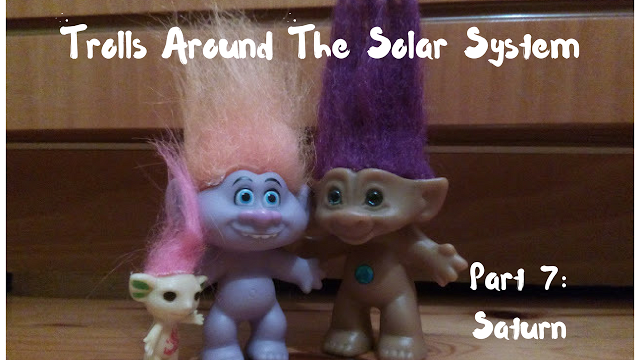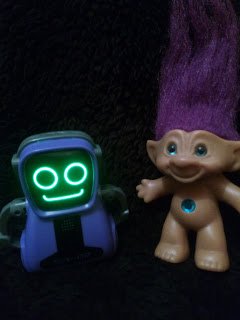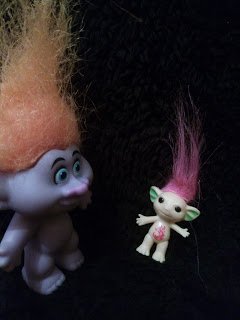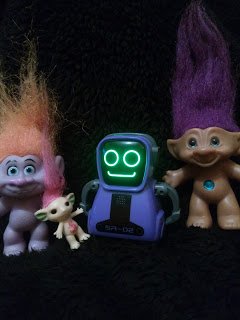Trolls Around The Solar System (Part 7- Saturn)
Go through the previous parts here: Part 1 (Mercury) - Part 2 (Venus) -Part 3 (Mars) - Part 4 (The Asteroid Belt) - Part 5 (Jupiter) - Part 6 (Jovian Moons)
After the tour of the Jovian moons, the trolls continued their space journey heading to Saturn. The beautiful gas giant with the impressive rings is waiting for them.
- Does Saturn have as many moons as Jupiter? X54 asked.
- Almost, X31 answered. Saturn has more than 50 natural satellites and some more are still pending for confirmation.
- He looks beatiful, though! X42 said in amazement.
The planet was in front of them now. The giant rings were circling Saturn, icy rocks and dust were spinning around the huge gas ball resembling a cosmic ballet company...
- These are the famous rings, guys! X31 said. They are the biggest and most complex ring system in our solar system. They make up seven whole sections, all made of objects of various sizes, from grain- to even house-big.
- And what makes them? I mean, why is all this material spinning around the planet? X42 asked.
- It is mostly the gravitational pull, T-800 explained. The remains of asteroids, comets and crashed moons are now orbiting the planet thanks to its immense power of gravity that turned them to rocks and dust.
- But they are not uniform, can you see them? X54 shouted!
- The rings display different patterns, X54. Strokes that last for a few hours or "braids" seem to appear because of comets and asteroids* crashing. Although it could be the planet's lightning causing the strokes, T-800 said.
- Are we going to land? X42 asked.
- That's a little difficult, X31 said. With a density lower than water's, Jupiter is a gas and liquid ball spinning at crazy speeds. I don't think it's a good idea to land there. The high pressures and heat coming out from the core would melt and smash our rocket.
Little X54 opened his eyes wide in terror and said:
- Ok, ok! We can just stay here and watch!
- What is all this gas and liquid, X31? X42 wanted to know.
- Saturn, just like the Sun and Jupiter, is made mostly of helium and hydrogen. The great pressures and heat form a smaller solid core out of rock, water, ice and other elements. A layer of liquid metallic hydrogen hides this core underneath it and another layer of liquid hydrogen covers them.
- And its upper atmosphere is covered in clouds, storms and stripes, T-800 added. The yellow ammonia crystals in them give this light brownish color to the planet. The planet also has top speed winds, blowing as fast as 500 m/second with the highest speeds spotted around the equator.
- Wow! That's a stronger than strong wind! X42 noticed.
- You said it is just like Jupiter but it's smaller than Jupiter, I can see that! X54 said.
- They have similar composition, but yes, Saturn is smaller, X31 answered. Still, Saturn is almost 760 times bigger than our home and has a very powerful magnetosphere, about 580 times stronger than Earth's.
- Saturn has also got auroras, like the Earth, T-800 added.
- And seasons, X31 went on. The planet is tilted almost as much as Earth, which means it can have seasons.
- You said earlier that Saturn spins very fast, what does this mean? X54 asked
- This means that it completes a full day-night cycle in about 10 and a half hours, X31 explained. It also means that the planet gets bulky in the equator.
- Another planet with a short day! Sometimes 24 hours is not enough, how would we manage if a day lasted only 10 and a half? X42 wondered.
- Well, a year lasts a lot longer, so it could make up for the shorter days, X31 said jokingly. A year on Saturn, a full orbit around the Sun, takes almost 29 Earth years.
- Guys, did you see that amazing hexagon around the North pole? X42 pointed out.
- Oh! It's the mysterious hexagon scientists have still not fully understood, T-800 replied.
- Yes, it is a unique in our solar system phenomenon, X31 added. A hexagonal wavy jet stream of winds raging at 300 km/h around a huge center with a fierce storm in it.
- The South pole has also its attractions, T-800 said. There is a menacing Cyclop living there, a hurricane with a huge eye.
- Saturn is an amazing place, scary, but amazing, X54 admitted.
- Yes, too bad it's too inhospitable for life, X42 said.
- It might be inhospitable, but some of its moons are not. Enceladus and Titan hold oceans that could bear life, T-800 said.
- Our world is unique, guys, X31 said. There is beauty and balance everywhere around us, even in the unbalances, even in the ferocious blasts and impacts of space, even deep within Saturn's hellish liquid grounds. We should respect the universe and the power that holds it together and be thankful for having the chance to be part of it.
To be continued...
References
space.com_1
space.com_2
solarsystem.nasa.gov
nationalgeographic.com
*comets and asteroids: visit the posts from @filotasriza3 to know the difference
Images and original story by @ruth-girl - Steemit, 2018
Thank you so much for your time!
Until my next post,
Steem on and keep smiling, people!







Even though i'm just getting to see this now, it's really an interesting and unique way of writing about the solar system... funny, but really good stuff dear.
Thank you!! I'm glad you liked it! :)
Kalispera... poli kalo... eisai apithani...😀😀😀
Γεια σου Νικο! Σε ευχαριστω πολυυυυ! :)
Beautiful Ruth! But X31 forgot to point out the South Polar Vortex :)
Thanks a lot! :)
Oh, T-800 mentioned it as "a hurricane with a huge eye", maybe that was a bit unclear, sorry...
My Bad!
Pretty interesting part. Your writing is really good :)
Thank you!
you are alawys use this cartuens .. do you love this cartuns?
I love them, yes!
Thank you too and keep up the good work
Thank you!